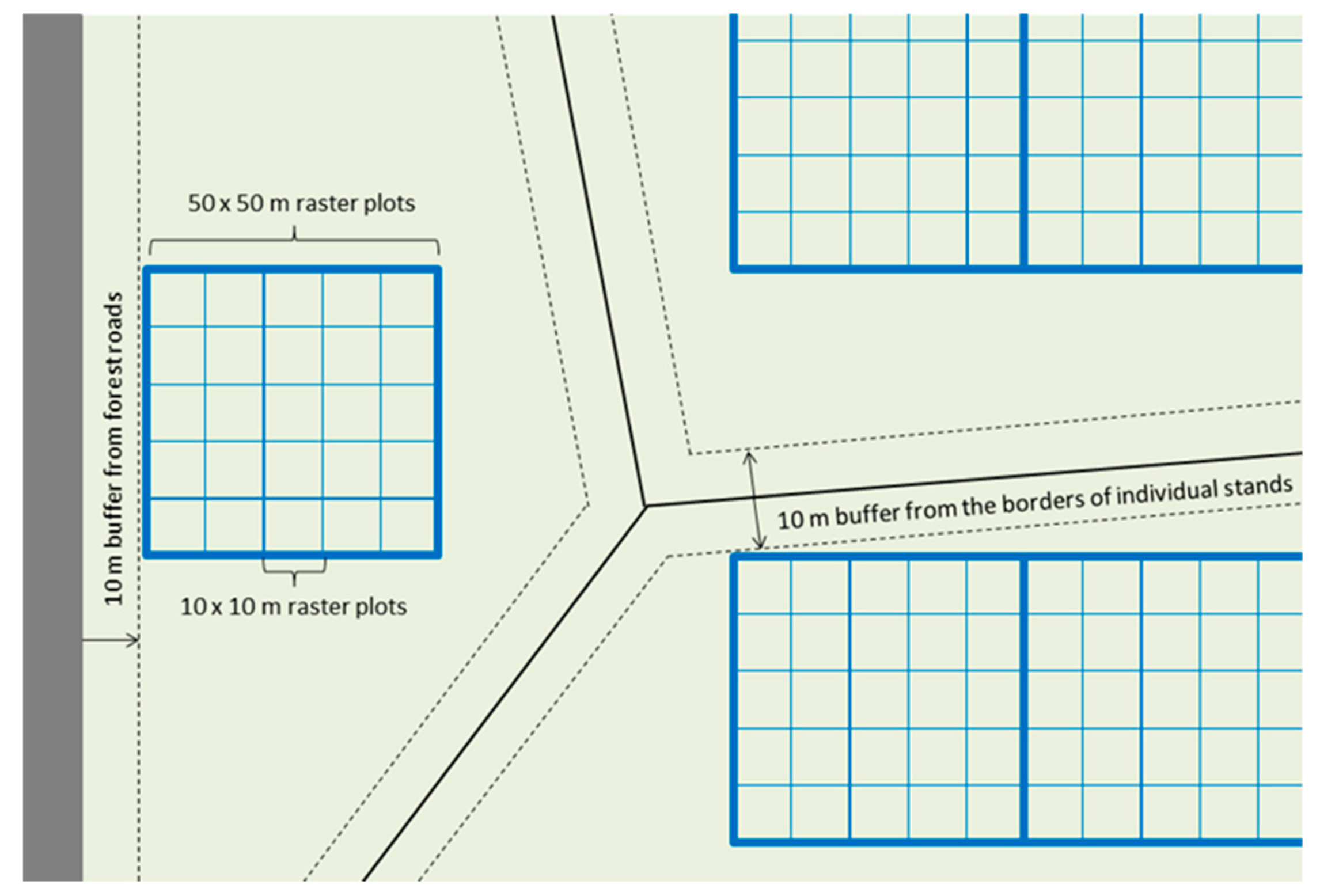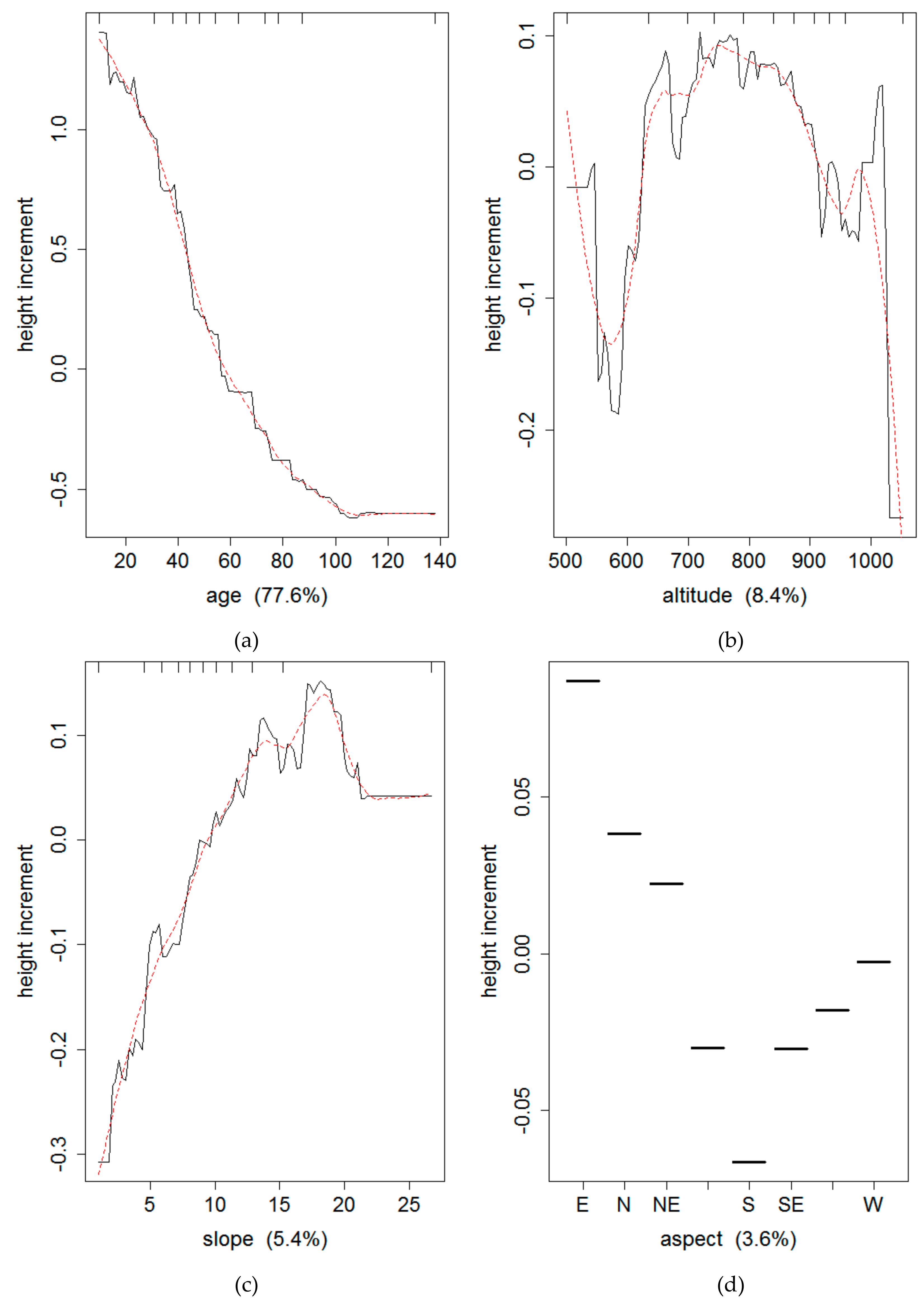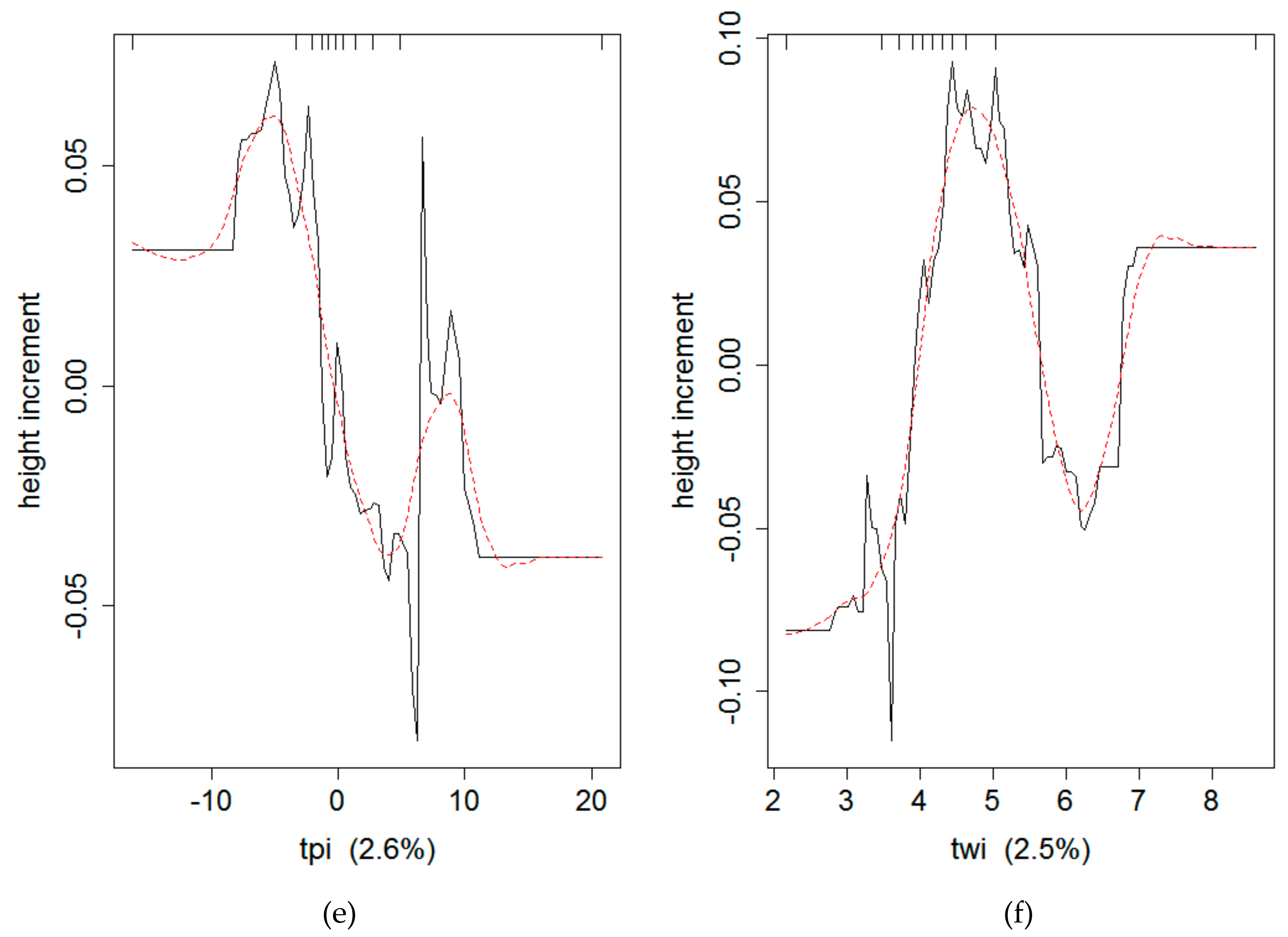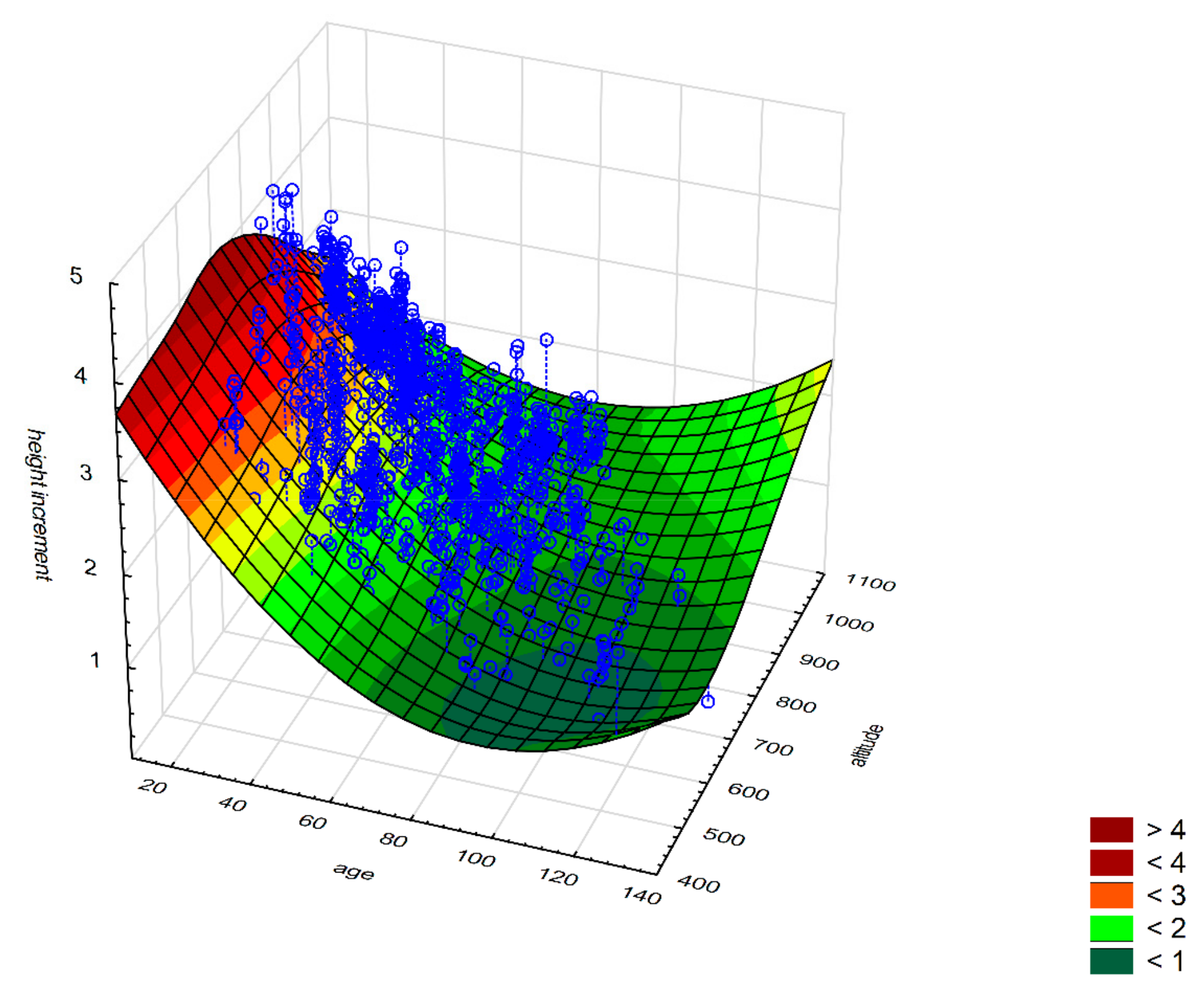Modeling the Effect of Environmental and Topographic Variables Affecting the Height Increment of Norway Spruce Stands in Mountainous Conditions with the Use of LiDAR Data
Abstract
1. Introduction
- detect the site-dependent variability of mean annual height increments,
- explore the dominant environmental factors limiting height growth using repeated ALS data obtained for the whole research area.
2. Materials and Methods
2.1. Study Area
2.2. Forest Digital Map Data and Information System
2.3. LiDAR Data
2.4. Processing the Digital Terrain Model (DTM) and Canopy Height Model (CHM)
- K—is the transformed value of aspect, varying from 0 to 2,
- A—is azimuth (degrees),
- Amax—is the assigned direction (azimuth) of maximum importance equal 45°.
- Z0—elevation of the model point under evaluation,
- Zn—elevation of the grid,
- n—the total number of surrounding points employed in the evaluation.
2.5. Statistical Analyses
3. Results
3.1. Results of Multiple Linear Regression
3.2. Boosted Regression Tree (BRT) Results
4. Discussion
5. Conclusions
Author Contributions
Funding
Conflicts of Interest
References
- Socha, J. Effect of topography and geology on the site index of Picea abies in the West Carpathian, Poland. Scand. J. For. Res. 2008, 23, 203–213. [Google Scholar] [CrossRef]
- Socha, J.; Ochal, W.; Maj, M.; Grabczynski, S.; Lach, J.; Gruba, P. Effect of elevation above sea level and geology on the site productivityfor European beech in the Beskid Żywiecki Mountains. Sylwan 2014, 158, 850–859. [Google Scholar]
- Etzold, S.; Waldner, P.; Thimonier, A.; Schmitt, M.; Dobbertin, M. Tree growth in Swiss forests between 1995 and 2010 in relation to climate and stand conditions: Recent disturbances matter. For. Ecol. Manag. 2014, 311, 41–55. [Google Scholar] [CrossRef]
- Hess, M. Piętra klimatyczne w polskich Karpatach Zachodnich. Zesz. Naukowe Uniw. Jagielońskiego Prace Geogr. 1974, 11, 1–258. [Google Scholar]
- Maciaszek, W.; Gruba, P.; Januszek, K.; Lasota, J.; Wanic, T.; Zwydak, M. Degradacja i Regradacja Gleb Pod Wpływem Gospodarki Leśnej na Terenie Żywiecczyzny; Wydawnictwo AR w: Krakowie, Poland, 2000. [Google Scholar]
- Balazy, R.; Ciesielski, M.; Zasada, M.; Zawiła-Niedzwiecki, T.; Waraksa, P. Forest dieback processes in the Central European mountains in the context of terrain topography and selected stand attributes. For. Ecol. Manag. 2019, 436, 106–119. [Google Scholar] [CrossRef]
- Hagglund, B.; Lundmark, J.E. Site index estimation by means of site properties Scots pine and Norway spruce in Sweden. Stud. For. Suec. 1997, 138, 5–38. [Google Scholar]
- Chen, H.Y.H.; Klinka, K.; Kabzems, R.D. Site index, site quality, and foliar nutrients of trembling aspen: Relationships and prediction. Can. J. For. Res. 1998, 28, 1743–1755. [Google Scholar] [CrossRef]
- Seynave, I.; Gegout, J.C.; Herve, J.C.; Dhote, J.F.; Drapier, J.B.E.; Dume, G. Picea abies site index prediction by environmental factors and understorey vegetation: A two-scale approach based on survey databases. Can. J. For. Res. 2005, 35, 1669–1678. [Google Scholar] [CrossRef]
- Monserud, R.A.; Moody, U.; Breuer, D.W. A soil-site study for inland Douglas-fir. Can. J. For. Res. 1990, 20, 686–695. [Google Scholar] [CrossRef]
- Wang, G.G.; Klinka, K. Use of synoptic variables in predicting white spruce site index. For. Ecol. Manag. 1996, 80, 95–105. [Google Scholar] [CrossRef]
- Chen, H.Y.H.; Krestov, P.V.; Klinka, K. Trembling aspen site index in relation to environmental measures of site quality at two spatial scales. Can. J. For. Res. 2002, 32, 112–119. [Google Scholar] [CrossRef]
- Elliott, K.J.; Vose, J.M.; Swank, W.T.; Bolstad, P.V. Long-term patterns in vegetation-site relationships in a southern Appalachian forest. J. Torrey Bot. Soc. 1999, 126, 320–334. [Google Scholar] [CrossRef]
- Fekedulegn, D.; Hicks, R.R.; Colbert, J.J. Influence of topographic aspect, precipitation and drought on radial growth of four major tree species in an Appalachian watershed. For. Ecol. Manag. 2003, 177, 409–425. [Google Scholar] [CrossRef]
- Albert, M.; Schmidt, M. Climate-sensitive modelling of site-productivity relationships for Norway spruce (Picea abies (L.) Karst.) and common beech (Fagus sylvatica L.). For. Ecol. Manag. 2010, 259, 739–749. [Google Scholar] [CrossRef]
- Farrelly, N.; Dhubhain, A.N.; Nieuwenhuis, M. Site index of Sitka spruce (Picea sitchensis) in relation to different measures of site quality in Ireland. Can. J. For. Res. 2011, 41, 265–278. [Google Scholar] [CrossRef]
- Watt, M.S.; Palmer, D.J.; Kimberley, M.O.; Hock, B.K.; Payn, T.W.; Lowe, D.J. Development of models to predict Pinus radiata productivity throughout New Zealand. Can. J. For. Res. 2010, 40, 488–499. [Google Scholar] [CrossRef]
- Blas, M. Rola Mgły w Przychodzie Wody z Atmosfery i Depozycji Zanieczyszczeń w Wybranych Ekosystemach Sudetów. Ph.D. Thesis, Zakład Meteorologii i Klimatologii Instytutu Geograficznego Uniwersytetu Wrocławskiego, Wrocław, Poland, 2000. [Google Scholar]
- Godek, M.; Migala, K.; Sobik, M. Air pollution and forest disaster in the Western Sudetes in the light of high elevation spruce tree-ring data. In Trace—Tree Ring in Archeology, Climatology and Ecology, Proceedings of the Dendrosymposium, Zakopane, Poland, 27–30 April 2008; Scientific Technical Report STR 09/03; GFZ Postdam: Potsdam, Germany, 2009; Volume 7, pp. 121–126. [Google Scholar]
- Night, G.D.; Krestov, P.V.; Klinka, K. Height growth of black spruce in British Columbia. For. Chron. 2002, 78, 306–313. [Google Scholar] [CrossRef]
- Sorensen, R.; Zinko, U.; Seibert, J. On the calculation of the topographic wetness index: Evaluation of different methods based on field observations. Hydrol. Earth Syst. Sci. 2006, 10, 101–112. [Google Scholar] [CrossRef]
- Junttila, O. Effects of temperature on shoot growth in northern provenances of Pinus sylvestris L. Tree Physiol. 1986, 1, 185–192. [Google Scholar] [CrossRef]
- Messaoud, Y.; Chen, H.Y.H. The Influence of Recent Climate Change on Tree Height Growth Differs with Species and Spatial Environment. PLoS ONE 2011, 6, e14691. [Google Scholar] [CrossRef]
- Gamache, I.; Payette, S. Height growth response of tree line black spruce to recent climate warming across the forest-tundra of eastern Canada. J. Ecol. 2004, 92, 835–845. [Google Scholar] [CrossRef]
- Salminen, H.; Jalkanen, R. Modelling the effect of temperature on height increment of Scots pine at high latitudes. Silv. Fenn. 2005, 39, 497–508. [Google Scholar] [CrossRef]
- Metslaid, S.; Sims, A.; Kangur, A.; Hordo, M.; Jogiste, K.; Kiviste, A.; Hari, P. Growth patterns from different forest generations of Scots pine in Estonia. J. For. Res. 2011, 16, 237–242. [Google Scholar] [CrossRef]
- Jansons, A.; Matisons, R.; Baumanis, I.; Purina, L. Effect of climatic factors on height increment of Scots pine in experimental plantation in Kalsnava, Latvia. For. Ecol. Manag. 2013, 306, 185–191. [Google Scholar] [CrossRef]
- Hilker, T.; Wulder, M.; Coops, N.C. Update of forest inventory data with lidar and high spatial resolution satellite imagery. Can. J. Remote Sens. 2008, 34, 5–12. [Google Scholar] [CrossRef]
- Wulder, M.; Bater, C.; Coops, N.; Hilker, T.; White, J. The role of LiDAR in sustainable forest management. For. Chron. 2008, 84, 807–826. [Google Scholar] [CrossRef]
- Muller, J.; Stadler, J.; Brandl, R. Composition versus physiognomy of vegetation as predictors of bird assemblages: The role of lidar. Remote Sens. Environ. 2010, 114, 490–495. [Google Scholar] [CrossRef]
- Yu, X.; Hyyppa, J.; Kukko, A.; Maltamo, M.; Kaartinen, H. Change detection techniques for canopy height growth measurements using airborne laser scanner data. Photogramm. Eng. Remote Sens. 2006, 72, 1339–1348. [Google Scholar] [CrossRef]
- Næsset, E.; Nelson, R. Using airborne laser scanning to monitor tree migration in the boreal-alpine transition zone. Remote Sens. Environ. 2007, 110, 357–369. [Google Scholar] [CrossRef]
- Yu, X.; Hyyppa, J.; Kaartinen, H.; Maltamo, M.; Hyyppa, H. Obtaining plotwise mean height and volume growth in boreal forests using multitemporal laser surveys and various change detection techniques. Int. J. Remote Sens. 2008, 29, 1367–1386. [Google Scholar] [CrossRef]
- Latypov, D. Estimating relative LiDAR accuracy information from overlapping flight lines. Photogramm. Eng. Remote Sens. 2002, 56, 236–245. [Google Scholar] [CrossRef]
- Hyyppa, J.; Yu, X.; Ronnholm, P.; Kaartinen, H.; Hyyppa, H. Factors affecting laser-derived object-oriented forest height growth estimation. Photogramm. J. Finl. 2003, 18, 16–31. [Google Scholar]
- St-Onge, B.; Vepakomma, U. Assessing Forest Gap Dynamics and Growth Using Multi Temporal Laser Scanner Data. In Proceedings of the LaserScanners for Forest and Landscape Assessment—Instruments, Processing Methods and Applications International Conference, Freiburg, Germany, 3–6 October 2004; pp. 173–178. [Google Scholar]
- Hopkinson, C.; Chasmer, L.; Hall, R.J. The uncertainty in conifer plantation growth prediction from multi-temporal lidar datasets. Remote Sens. Environ. 2008, 112, 1168–1180. [Google Scholar] [CrossRef]
- Yu, X.; Hyyppa, J.; Kaartinen, H.; Maltamo, M. Automatic detection of harvested trees and determination of forest growth using airborne laser scanning. Remote Sens. Environ. 2004, 90, 451–462. [Google Scholar] [CrossRef]
- Elith, J.; Leathwick, J.R.; Hastie, T. A working guide to boosted regression trees. J. Anim. Ecol. 2008, 77, 802–813. [Google Scholar] [CrossRef]
- Sterenczak, K.; Ciesielski, M.; Balazy, R.; Zawila-Niedzwiecki, T. Comparison of various algorithms for DTM interpolation from LIDAR data in dense mountains forests. Eur. J. Remote Sens. 2016, 49, 599–621. [Google Scholar] [CrossRef]
- Beers, T.W.; Dress, P.E.; Wensel, L.C. Aspect transformation in site productivity research. J. For. 1966, 64, 691692. [Google Scholar]
- Boehner, J.; Koethe, R.; Conrad, O.; Gross, J.; Ringeler, A.; Selige, T. Soil Regionalisation by Means of Terrain Analysis and Process Parameterisation. In Soil Classification 2001; Research Report No. 7, EUR 20398 EN; Micheli, E., Nachtergaele, F., Montanarella, L., Eds.; European Soil Bureau: Luxembourg, 2002. [Google Scholar]
- Jenness, J. Topographic Position Index (tpi_jen.avx) Extension for ArcView 3.x, v. 1.2; Jenness Enterprises: Flagstaff, AZ, USA, 2006; Available online: http://www.jennessent.com/arcview/tpi.htm (accessed on 16 October 2019).
- Mielcarek, M.; Balazy, R.; Zawila-Niedzwiecki, T. Comparison of the accuracy of remote methods of tree−height estimation. Sylwan 2015, 159, 714–721. [Google Scholar]
- Socha, J.; Pierzchalski, M.; Balazy, R.; Ciesielski, M. Modelling top height growth and site index using repeated laser scanning data. For. Ecol. Manag. 2017, 406, 307–317. [Google Scholar] [CrossRef]
- De’ath, G.; Fabricius, K.E. Classification and regression trees: A powerful yet simple technique for ecological data analysis. Ecology 2000, 81, 3178–3192. [Google Scholar] [CrossRef]
- Chirici, G.; Mura, M.; McInerney, D.; Py, N.; Tomppo, E.O.; Waser, L.T.; McRoberts, R.E. A meta-analysis and review of the literature on the k-Nearest Neighbors technique for forestry applications that use remotely sensed data. Remote Sens. Environ. 2016, 176, 282–294. [Google Scholar] [CrossRef]
- Noordermeer, L.; Okseter, R.; Orka, H.O.; Gobakken, T.; Næsset, E.; Bollandsas, O.M. Classifications of Forest Change by Using Bitemporal Airborne Laser Scanner Data. Remote Sens. 2019, 11, 2145. [Google Scholar] [CrossRef]
- Watanachaturaporn, P.; Varshney, P.K.; Arora, M.K. Decision tree regression for soft classification of remote sensing data. Remote Sens. Environ. 2005, 97, 322–336. [Google Scholar]
- Niska, H.; Skon, J.P.; Packalen, P.; Tokola, T.; Maltamo, M.; Kolehmainen, M. Neural networks for the prediction of species-specific plot volumes using airborne laser scanning and aerial photographs. IEEE Trans. Geosci. Remote Sens. 2009, 48, 1076–1085. [Google Scholar] [CrossRef]
- Karvemo, S.; Van Boeckel, T.P.; Gilbert, M.; Gregoire, J.-C.; Schroeder, M. Large-scale risk mapping of an eruptive bark beetle—Importance of forest susceptibility and beetle pressure. For. Ecol. Manag. 2014, 318, 158–166. [Google Scholar] [CrossRef]
- Mezei, P.; Grodzki, W.; Blazenec, M.; Skvarenina, J.; Brandysova, V.; Jakus, R. Host and site factors affecting tree mortality caused by the spruce bark beetle (Ips typographus) in mountainous conditions. For. Ecol. Manag. 2014, 331, 196–207. [Google Scholar] [CrossRef]
- Ridgeway, G.; The gbm Package. Generalized Boosted Regression Models (Documentation on the R Package ‘gbm’, Version 1.6-3). 2007. Available online: https://cran.r-project.org/web/packages/gbm/gbm.pdf (accessed on 16 October 2019).
- Elith, J.; Leathwick, J. Boosted Regression Trees for Ecological Modelling. 2014. Available online: http://cran.r-project.org/web/packages/dismo/vignettes/brt.pdf (accessed on 16 October 2019).
- Zawila-Niedzwiecki, T. Evaluation of forest state in threatened ecosystems with the use of satellite imagery and GIS. Proc. Inst. Geod. Cartogr. 1994, 41, 90. [Google Scholar]
- Saremi, H.; Kumar, L.; Turner, R.; Stone, C.; Melville, G. Impact of local slope and aspect assessed from LiDAR records on tree diameter in radiata pine (Pinus radiata D. Don) plantations. Ann. For. Sci. 2014, 71, 771–780. [Google Scholar] [CrossRef]
- Saremi, H.; Kumar, L.; Turner, R.; Stone, C. Airborne LiDAR derived canopy height model reveals a significant difference in radiata pine (Pinus radiata D. Don) heights based on slope and aspect of sites Trees. Trees 2014, 28, 733–744. [Google Scholar] [CrossRef]
- Gieruszynski, T. Wpływ wystawy na wzrost i zasobność drzewostanów świerkowych w Karpatach wschodnich. Sylwan 1936, 54, 47–93. [Google Scholar]
- Trimble, G.R., Jr.; Weitzman, S. Site index studies of upland oaks in the northern Appalachians. For. Sci. 1956, 2, 162–173. [Google Scholar]
- Doolittle, W.T. Site index of scarlet and black oak in relation to southern Appalachian soil and topography. For. Sci. 1957, 3, 116–124. [Google Scholar]
- Doolittle, W.T. Site index comparisons for several forest species in the southern Appalachians. Soil Sci. Soc. Am. J. 1958, 22, 455–458. [Google Scholar] [CrossRef]
- Trimble, G.R., Jr. An equation for predicting oak site index without measuring soil depth. J. For. 1964, 62, 325–327. [Google Scholar]
- Olson, D.F., Jr. Silvical Characteristics of Yellow-Poplar (Liriodendron tulipifera L.); USDA Forest Service, Research Paper SE-48; Southeastern Forest Experiment Station: Asheville, NC, USA, 1969; p. 16.
- Lee, R.; Sypolt, C.R. Toward a biological evaluation of forest site potential. For. Sci. 1974, 20, 145–154. [Google Scholar]
- Perin, J.; Hebert, J.; Brostaux, Y.; Lejeune, P.; Claessens, H. Modelling the top-height growth and site index of Norway spruce in Southern Belgium. For. Ecol. Manag. 2013, 298, 62–70. [Google Scholar] [CrossRef]
- Andersen, H.E.; McGaughey, R.J.; Reutebuch, S.E. Forest Measurement and monitoring using high-resolution airborne Lidar. In Productivity of Western Forests: A Forest Products Focus; General Technical Report PNW-GTR-642; U.S. Forest Service: Washington, DC, USA, 2005; pp. 109–120. [Google Scholar]
- Næsset, E. Practical large scale forest stand inventory using a small-footprint airborne scanning laser. Scand. J. For. Res. 2014, 19, 164–179. [Google Scholar] [CrossRef]
- Tryon, C.P.; Beers, T.W.; Meeritt, C. The measurement of site quality for yellow-poplar. J. For. 1960, 58, 968–969. [Google Scholar]
- Auchmoody, L.R.; Smith, H.C. Oak Soil-Site Relationships in Northwestern West Virginia; Research Paper NE-434; Forest Service U.S. Department of Agriculture: Washington, DC, USA, 1979; p. 27.
- Sprackling, J. Soil-Topographic Site Index for Engelmann Spruce on Granitic Soils in Northern Colorado and Southern Wyoming; Forest Service U.S. Department of Agriculture: Fort Collins, CO, USA, 1973; pp. 1–4.
- Klinka, K.; Chen, H.Y.H. Potential productivity of three interior subalpine forest tree species in British Columbia. For. Ecol. Manag. 2003, 175, 521–530. [Google Scholar] [CrossRef]
- Socha, J. Zależność bonitacji drzewostanów świerkowych od wysokości położenia nad poziomem morza. Sylwan 1988, 9, 25–31. [Google Scholar]
- Bruchwald, A.; Kliczkowska, A. Kształtowanie się bonitacji drzewostanów świerkowych na terenach górskich (Quality of spruce stands in mountain areas). Sylwan 2000, 9, 5–15. [Google Scholar]
- Chen, H.Y.H.; Klinka, K. Height Growth Models for High-Elevation Subalpine Fir, Engelmann Spruce, and Lodgepole Pine in British Columbia. West. J. Appl. For. 2000, 15, 62–69. [Google Scholar] [CrossRef][Green Version]
- Leathwick, J.R.; Elith, J.; Hastie, C. Comparative performance of generalized additive models and multivariate adaptive regression splines for statistical modelling of species distributions. Ecol. Model. 2006, 199, 188–196. [Google Scholar] [CrossRef]
- Martin, V.; Pfeiffer, D.U.; Zhou, X.; Xiao, X.; Prosser, D.J.; Guo, F.; Gilbert, M. Spatial distribution and risk factors of highly pathogenic avian influenza (HPAI) H5N1 in China. PLoS Pathog. 2011, 7, e1001308. [Google Scholar] [CrossRef]





| Parameters | Value (ALS 2007) | Value (ALS 2012) |
|---|---|---|
| File format saving | LAS 1.3 | LAS 1.3 |
| Acquisition date | August and September | July and August |
| Average point density (first impulses) | 4 pts./m2 | 6 pts./m2 |
| Average altitude error | ≤0.15m | ≤0.15m |
| Average error grid coordinates | ≤0.40m | ≤0.20m |
| Cross-track overlap | Minimum 50% | Minimum 50% |
| Type of laser scanner | ALTM 3100 Optech laser scanner | LMS-Q680i |
| Digital Surface Model | DTM, DSM, nDSM (spatial resolution 0.5 m) | |
| Factors | MLR1 | MLR2 | |||
|---|---|---|---|---|---|
| Estimates (p-Values) | Standard Errors | Estimates (p-Values) | Standard Errors | ||
| age | - | - | −0.81 (<0.01) | 0.01 | |
| altitude | 0.12 (<0.01) | 0.02 | −0.03 (0.07) | 0.01 | |
| slope | 0.02 (0.54) | 0.03 | 0.13 (0.01) | 0.02 | |
| aspect | 0.03 (0.23) | 0.02 | −0.04 (<0.01) | 0.01 | |
| TPI | −0.11 (<0.01) | 0.03 | −0.05 (<0.01) | 0.02 | |
| TWI | −0.01(0.83) | 0.03 | −0.01 (0.80) | 0.02 | |
| model R | 0.15 | - | 0.80 | - | |
| Variable | Height Increment | Altitude | Slope | TPI | TWI | Aspect |
|---|---|---|---|---|---|---|
| Height increment | 1.000 | 0.105 | 0.010 | −0.094 | 0.029 | 0.043 |
| altitude | 0.105 | 1.000 | −0.134 | 0.126 | 0.080 | 0.183 |
| slope | 0.010 | −0.134 | 1.000 | −0.039 | −0.647 | −0.091 |
| TPI | −0.094 | 0.126 | −0.039 | 1.000 | −0.347 | 0.033 |
| TWI | 0.029 | 0.080 | −0.647 | −0.347 | 1.000 | 0.031 |
| aspect | 0.043 | 0.183 | −-0.091 | 0.033 | 0.031 | 1.000 |
| Predictor Type | Variable | Height Increment (m) | |
|---|---|---|---|
| BRT1 | BRT2 | ||
| Stand | Age | - | 76.06 |
| Topographic | Altitude | 31.11 | 9.70 |
| Slope | 18.27 | 5.84 | |
| TPI | 14.42 | 2.84 | |
| Aspect | 20.11 | 3.17 | |
| TWI | 16.09 | 2.38 | |
| R training | - | 0.81 | 0.92 |
| R CV | - | 0.53 | 0.87 |
| Standard error | - | 0.009 | 0.004 |
© 2019 by the authors. Licensee MDPI, Basel, Switzerland. This article is an open access article distributed under the terms and conditions of the Creative Commons Attribution (CC BY) license (http://creativecommons.org/licenses/by/4.0/).
Share and Cite
Bałazy, R.; Kamińska, A.; Ciesielski, M.; Socha, J.; Pierzchalski, M. Modeling the Effect of Environmental and Topographic Variables Affecting the Height Increment of Norway Spruce Stands in Mountainous Conditions with the Use of LiDAR Data. Remote Sens. 2019, 11, 2407. https://doi.org/10.3390/rs11202407
Bałazy R, Kamińska A, Ciesielski M, Socha J, Pierzchalski M. Modeling the Effect of Environmental and Topographic Variables Affecting the Height Increment of Norway Spruce Stands in Mountainous Conditions with the Use of LiDAR Data. Remote Sensing. 2019; 11(20):2407. https://doi.org/10.3390/rs11202407
Chicago/Turabian StyleBałazy, Radomir, Agnieszka Kamińska, Mariusz Ciesielski, Jarosław Socha, and Marcin Pierzchalski. 2019. "Modeling the Effect of Environmental and Topographic Variables Affecting the Height Increment of Norway Spruce Stands in Mountainous Conditions with the Use of LiDAR Data" Remote Sensing 11, no. 20: 2407. https://doi.org/10.3390/rs11202407
APA StyleBałazy, R., Kamińska, A., Ciesielski, M., Socha, J., & Pierzchalski, M. (2019). Modeling the Effect of Environmental and Topographic Variables Affecting the Height Increment of Norway Spruce Stands in Mountainous Conditions with the Use of LiDAR Data. Remote Sensing, 11(20), 2407. https://doi.org/10.3390/rs11202407








